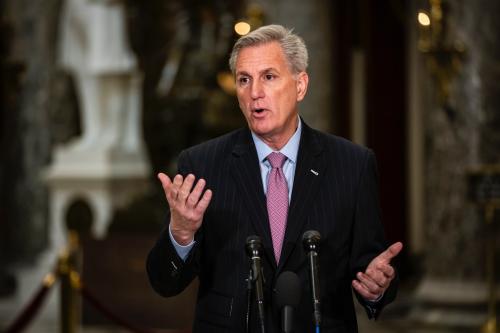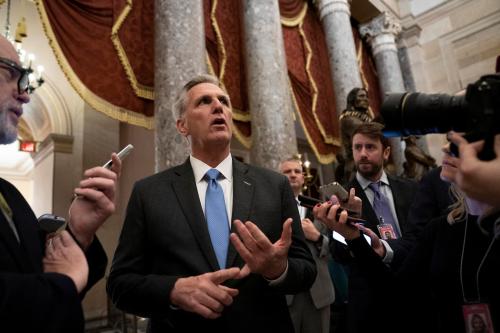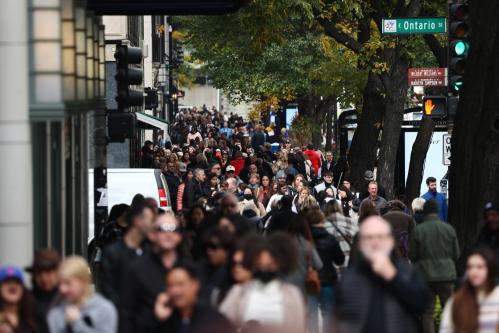During the past four decades, the two major political parties have steadily moved farther away from each other and are now as deeply divided as they have been for more than a century. For most of this period, analysts agree, Republican elected officials have moved more to the right than Democratic officials have to the left.
But there’s a paradox: since the early 1990s, according to Gallup, Democratic voters have shifted more to the left than Republican voters have to the right. In 1994, the second year of Bill Clinton’s presidency, 25% of Democrats thought of themselves as liberal and the same share—25%—called themselves conservative. A strong plurality of Democrats—48%—identified as moderate.
By 2022, the second year of Joe Biden’s presidency, the picture had entirely changed. An outright majority of Democrats—54%—now called themselves liberal, while the share of conservatives fell to just 10%. Moderates, who once outnumbered the party’s liberals by 23 percentage points, now trailed them by 18 points.
The Republican Party has changed far less during this period, largely because it has long been more ideologically homogeneous at the grassroots. In 1994, 58% of Republicans were conservative, a figure that rose to 72% in 2022. During these three decades, Republican moderates fell from 33% to 22% while Republican liberals (already an endangered species in the early 1990s), declined from eight percent to just five percent.
For Democrats, the ideological changes have varied significantly along racial and ethnic lines. In 1994, White, Black, and Hispanic Democrats were equally likely to think of themselves as liberal. But during the next three decades, the share of White Democrats who identify as liberal rose by 37 points, from 26% to 63%, while Black and Hispanic Democrats rose by less than half as much, to 39% and 41%, respectively.
The outcome: unlike three decades ago, the Democrat Party is now a coalition of White Liberals and non-white voters the majority of whom think of themselves as moderate or conservative. It is not a coincidence that the majority of Whites who voted for Joe Biden in 2020 rarely if ever attend church, while more than 90% of Black Biden supporters attend monthly or more. Nor was it an anomaly that the mostly Black primary voters in South Carolina backed Joe Biden, the most moderate Democratic candidate in 2020, propelling him to victory in the 2020 contest for the presidential nomination.
The analysis for Hispanics is more complex. Most attend religious services regularly, but Hispanic Catholics are more likely to identify with Democrats than are Hispanic evangelicals, whose share of the Hispanic vote has been increasing significantly. We also know that Hispanics are skeptical of parties they regard as increasingly liberal and conservative. In a survey released on January 18, 2023, 46% of Hispanic voters said that the Democratic Party has moved too far to the left, compared to 41% who said that the Republican Party has moved too far to the right. These figures mirror the electorate as a whole—more evidence that Hispanics are becoming a swing vote rather than a reliable pillar of the Democratic base.
This analysis of ideological change within the parties leaves several questions unanswered. Many voters are liberal on economic issues but conservative on cultural issues, or vice versa. When such voters identify themselves ideologically, it is not always clear which element of their outlook is taking priority. Nor is it clear that the meaning of ideological labels has remained constant over time.
Still, there is a close and enduring relationship between ideological self-identification and voting patterns. Almost all liberals will vote for Democrats and conservatives for Republicans, while moderates are more likely to shift between parties based on the specific choices they confront. Hillary Clinton received just 52% of the moderate vote in her 2016 defeat while Joe Biden garnered 64% in his 2020 victory. Because almost 4 in 10 voters are moderates, their votes are often decisive.
Although the analysis of party coalitions through the lens of ideology is imperfect, it helps reveal the structure of party competition, and it explains why going too far in one direction or the other can diminish a party’s chances of winning, as it did in 2020 and in key state races in 2022.
The Brookings Institution is committed to quality, independence, and impact.
We are supported by a diverse array of funders. In line with our values and policies, each Brookings publication represents the sole views of its author(s).








Commentary
The polarization paradox: Elected officials and voters have shifted in opposite directions
January 20, 2023